Theoretical Study of InAlN/GaN High Electron Mobility Transistor (HEMT) with a Polarization-Graded AlGaN Back-Barrier Layer
Abstract
:1. Introduction
2. Device Description and Physical Models
3. Results and Discussion
4. Conclusions
Author Contributions
Funding
Acknowledgments
Conflicts of Interest
References
- Mishra, U.K.; Parikh, P.; Wu, Y.F. AlGaN/GaN HEMTs-an overview of device operation and applications. Proc. IEEE 2002, 90, 1022–1031. [Google Scholar] [CrossRef]
- Mishra, U.K.; Shen, L.; Kazior, T.E.; Wu, Y.F. GaN-based RF power devices and amplifiers. Proc. IEEE 2008, 96, 287–305. [Google Scholar] [CrossRef]
- Frayssinet, E.; Knap, W.; Lorenzini, P.; Grandjean, N.; Massies, J.; Skierbiszewski, C.; Suski, T. High electron mobility in AlGaN/GaN heterostructures grown on bulk GaN substrates. Appl. Phys. Lett. 2000, 77, 2551–2553. [Google Scholar] [CrossRef] [Green Version]
- Visalli, D.; Van Hove, M.; Derluyn, J.; Degroote, S.; Leys, M.; Cheng, K.; Germain, M.; Borghs, G. AlGaN/GaN/AlGaN double heterostructures on silicon substrates for high breakdown voltage field-effect transistors with low on-resistance. Jpn. J. Appl. Phys. 2009, 48, 04C101. [Google Scholar] [CrossRef]
- Kuzuhara, M.; Tokuda, H. Low-loss and high-voltage III-nitride transistors for power switching applications. IEEE Trans. Electron Devices 2015, 62, 405–413. [Google Scholar] [CrossRef]
- Kuzmik, J. Power electronics on InAlN/(In) GaN: Prospect for a record performance. IEEE Electron Devices Lett. 2001, 22, 510–512. [Google Scholar] [CrossRef]
- Feng, Z.H.; Zhou, Y.G.; Cai, S.J.; Lau, K.M. Enhanced thermal stability of the two-dimensional electron gas in GaN/AlGaN/GaN heterostructures by Si3N4 surface-passivation-induced strain solidification. Appl. Phys. Lett. 2004, 85, 5248–5250. [Google Scholar] [CrossRef]
- Joh, J.; Alamo, J.D. Impact of electrical degradation on trapping characteristics of GaN HEMTs. In Proceedings of the 2008 IEEE International Electron Devices Meeting, San Francisco, CA, USA, 15–17 December 2008. [Google Scholar]
- Lin, Z.; Kim, H.; Lee, J. Thermal stability of Schottky contacts on strained AlGaN/GaN heterostructures. Appl. Phys. Lett. 2004, 84, 1585–1587. [Google Scholar] [CrossRef] [Green Version]
- Neuburger, M.; Zimmermann, T.; Kohn, E.; Dadgar, A.; Schulze, F.; Günther, M.; Witte, H.; BlӒsing, J.; Krost, A.; daumiller, I.; et al. Unstrained InAlN/GaN HEMT structure. Int. J. High Speed Electron. Syst. 2004, 14, 785–790. [Google Scholar] [CrossRef]
- Ge, M.; Cai, Q.; Zhang, B.H.; Chen, D.J.; Hu, L.Q.; Xue, J.J.; Lu, H.; Zhang, R.; Zheng, Y.D. Effects of the trap level in the unintentionally doped GaN buffer layer on optimized p-GaN gate AlGaN/GaN HEMTs. Phys. Status Solidi A 2018, 215, 1700368. [Google Scholar] [CrossRef]
- Kuzmík, J.; Kostopoulos, A.; Konstantinidis, G.; Carlin, J.F.; Georgakilas, A.; Pogany, D. InAlN/GaN HEMTs: A first insight into technological optimization. IEEE Trans. Electron Devices 2006, 53, 422–426. [Google Scholar] [CrossRef]
- Kuzmík, J. InAlN/(In) GaN high electron mobility transistors: Some aspects of the quantum well heterostructure proposal. Semicond. Sci. Technol. 2002, 17, 540–544. [Google Scholar] [CrossRef]
- Medjdoub, F.; Carlin, J.F.; Gaquière, C.; Grandjean, N.; Kohn, E. Status of the emerging InAlN/GaN power HEMT technology. Open Electr. Electron. Eng. J. 2008, 2, 1–7. [Google Scholar] [CrossRef]
- Shrestha, N.M.; Li, Y.; Chang, E.Y. Simulation study on electrical characteristic of AlGaN/GaN high electron mobility transistors with AlN spacer layer. Jpn. J. Appl. Phys. 2014, 53, 04EF08. [Google Scholar] [CrossRef] [Green Version]
- Teke, A.; Gokden, S.; Tulek, R.; Leach, J.H.; Fan, Q.; Xie, J.; Ozgur, U.; Morkoc, H.; Lisesivdin, S.B.; Ozbay, E. The effect of AlN interlayer thicknesses on scattering processes in lattice-matched AlInN/GaN two-dimensional electron gas heterostructures. New J. Phys. 2009, 11, 063031. [Google Scholar] [CrossRef]
- Khan, M.A.; Kuznia, J.N.; Van Hove, J.M.; Pan, N.; Carter, J. Observation of a two-dimensional electron gas in low pressure metalorganic chemical vapor deposited GaN-AlxGa1−xN heterojunctions. Appl. Phys. Lett. 1992, 60, 3027–3029. [Google Scholar] [CrossRef]
- Imanaga, S.; Kawai, H. Novel AlN/GaN insulated gate heterostructure field effect transistor with modulation doping and one-dimensional simulation of charge control. J. Appl. Phys. 1997, 82, 5843–5858. [Google Scholar] [CrossRef]
- Chen, C.Q.; Zhang, J.P.; Adivarahan, V.; Koudymov, A.; Fatima, H.; Simin, G. AlGaN/GaN/AlGaN double heterostructure for high-power III-N field-effect transistors. Appl. Phys. Lett. 2003, 82, 4593. [Google Scholar] [CrossRef]
- Lee, D.S.; Gao, X.; Guo, S. InAlN/GaN HEMTs with AlGaN back barriers. IEEE Electron Devcies Lett. 2011, 32, 617–619. [Google Scholar] [CrossRef]
- Meng, F.; Zhang, J.; Zhou, H. Transport characteristics of AlGaN/GaN/AlGaN double heterostructures with high electron mobility. J. Appl. Phys. 2012, 112, 023707. [Google Scholar] [CrossRef]
- Yao, C.J.; Yang, G.F.; Li, Y.J.; Sun, R.; Zhang, Q.; Wang, J.; Gao, S.M. Investigation of N-face AlGaN ultraviolet light-emitting diodes with composition-varying AlGaN electron blocking layer. Opt. Quant. Electron. 2016, 48, 31. [Google Scholar] [CrossRef]
- Yao, C.J.; Ye, X.C.; Sun, R.; Yang, G.F.; Wang, J.; Lu, Y.N.; Yan, P.F.; Cao, J.T.; Gao, S.M. High-performance AlGaN-based solar-blind avalanche photodiodes with dual-periodic III–nitride distributed Bragg reflectors. Appl. Phys. Express 2017, 10, 034302. [Google Scholar] [CrossRef]
- Wang, H.; Jiang, L.L.; Wang, N.; Yu, H.Y.; Lin, X.P. A Charge Storage Based Enhancement Mode AlGaN/GaN High Electron Mobility Transistor. Mater. Sci. Forum 2018, 913, 870–875. [Google Scholar] [CrossRef]
- Della Corte, F.G.; Pezzimenti, F.; Bellone, S.; Nipoti, R. Numerical simulations of a 4H-SiC BMFET power transistor with normally-off characteristics. Mater. Sci. Forum 2011, 679–680, 621–624. [Google Scholar] [CrossRef]
- Anvarifard, M.K.; Orouji, A.A. Proper Electrostatic Modulation of Electric Field in a Reliable Nano-SOI With a Developed Channel. IEEE Trans. Electron Devices 2018, 65, 1653–1657. [Google Scholar] [CrossRef]
- Pezzimenti, F. Modeling of the steady state and switching characteristics of a normally-off 4H-SiC trench bipolar-mode FET. IEEE Trans. Electron Devices 2013, 60, 1404–1411. [Google Scholar] [CrossRef]
- Della Corte, F.G.; de Martino, G.; Pezzimenti, F.; Adinolfi, G.; Graditi, G. Numerical simulation study of a low breakdown voltage 4H-SiC MOSFET for photovoltaic module-level applications. IEEE Trans. Electron Devices 2018, 65, 3352–3360. [Google Scholar] [CrossRef]
- Wang, Y.; Li, Z.Y.; Hao, Y.; Luo, X.; Fang, J.P.; Ma, Y.C.; Yu, H.Y.; Cao, F. Evaluation by Simulation of AlGaN/GaN Schottky Barrier Diode (SBD) With Anode-Via Vertical Field Plate Structure. IEEE Trans. Electron Devices 2018, 65, 2552–2557. [Google Scholar] [CrossRef]
- Faramehr, S.; Kalna, K.; Igić, P. Modeling of 2DEG and 2DHG in i-GaN capped AlGaN/AlN/GaN HEMTs. In Proceedings of the International Conference on Microelectronics, Belgrade, Serbia, 12–14 May 2014; pp. 81–84. [Google Scholar]
- Ochiai, M.; Akita, M.; Ohno, Y.; Kishimoto, S.; Maezawa, K.; Mizutani, T. AlGaN/GaN heterostructure metal-insulator-semiconductor high-electron-mobility transistors with Si3N4 gate insulator. Jap. J. Appl. Phys. 2003, 42, 2278–2280. [Google Scholar] [CrossRef]
- Han, T.; Zhao, H.; Peng, X.; Li, Y. Control of short-channel effects in InAlN/GaN high-electron mobility transistors using graded AlGaN buffer. Superlattice Microst. 2018, 116, 207–214. [Google Scholar] [CrossRef]
- MorkoC, H.; Cingolani, R.; Gil, B. Polarization effects in nitride semiconductor device structures and performance of modulation doped field effect transistors. Solid-State Electron. 1999, 43, 1909–1927. [Google Scholar] [CrossRef]
- Ambacher, O.; Smart, J.; Shealy, J.R.; Weimann, N.G.; Chu, K.; Murphy, M.; Schaff, W.J.; Eastman, L.F.; Dimitrov, R.; Wittmer, L.; et al. Two-dimensional electron gases induced by spontaneous and piezoelectric polarization charges in N- and Ga-face AlGaN/GaN heterostructures. J. Appl. Phys. 1999, 87, 3222–3233. [Google Scholar] [CrossRef]
- Ambacher, O.; Majewski, J.; Miskys, C.; Link, A.; Hermann, M.; Eickhoff, M.; Stutzmann, M.; Bernardini, F.; Fiorentini, V.; Tilak, V.; et al. Pyroelectric properties of Al (In) GaN/GaN hetero-and quantum well structures. J. Phys. Condens. Matter 2002, 14, 3399–3434. [Google Scholar] [CrossRef]
- Pelá, R.R.; Caetano, C.; Ferreira, L.G.; Furthmüller, J.; Teles, L.K. Accurate band gaps of AlGaN, InGaN, and AlInN alloys calculations based on LDA-1/2 approach. Appl. Phys. Lett. 2011, 98, 151907. [Google Scholar] [CrossRef]
- Goswami, A.; Trew, R.J.; Bilbro, G.L. Physics of gate leakage current in N-polar InAlN/GaN heterojunction field effect transistors. J. Appl. Phys. 2014, 116, 164508. [Google Scholar] [CrossRef]
- SILVACO Int. ATLAS User’s Manual; Device Simulation Software: Santa Clara, CA, USA, 2016; Available online: https://www.silvaco.com (accessed on 1 February 2013).
- Hall, R.N. Electron-hole recombination in germanium. Phys. Rev. 1952, 87, 387. [Google Scholar] [CrossRef]
- Shockley, W. Statistics of the recombinations of holes and electrons. Phys. Rev. 1952, 87, 835–842. [Google Scholar] [CrossRef]
- Megherbi, M.L.; Pezzimenti, F.; Dehimi, L.; Saadoune, M.A.; Della Corte, F.G. Analysis of trapping effects on the forward current-voltage characteristics of al-implanted 4H-SiC p-i-n Diodes. IEEE Trans. Electron Devices 2018, 65, 3371–3378. [Google Scholar] [CrossRef]
- Inoue, T.; Nakayama, T.; Ando, Y.; Kosaki, M.; Miwa, H.; Hirata, K.; Uemura, T.; Miyamoto, H. Polarization engineering on buffer layer in GaN-based heterojunction FETs. IEEE Trans. Electron. Devices 2008, 55, 483–488. [Google Scholar] [CrossRef]
- Li, C.; Li, Z.; Peng, D.; Ni, J.; Pan, L.; Zhang, D. Improvement of breakdown and current collapse characteristics of GaN HEMT with a polarization-graded AlGaN buffer. Semicond. Sci. Technol. 2015, 30, 035007. [Google Scholar] [CrossRef]
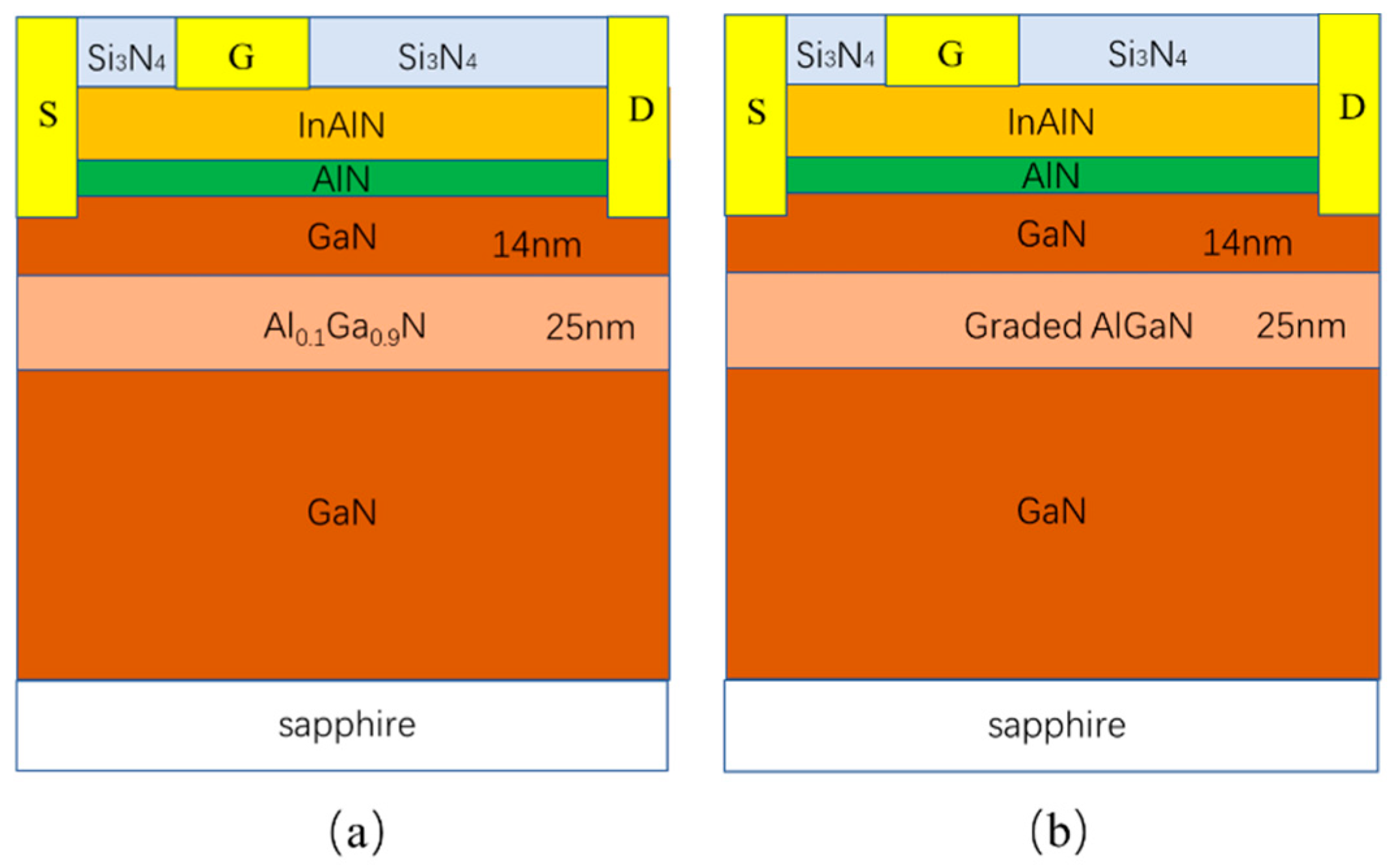
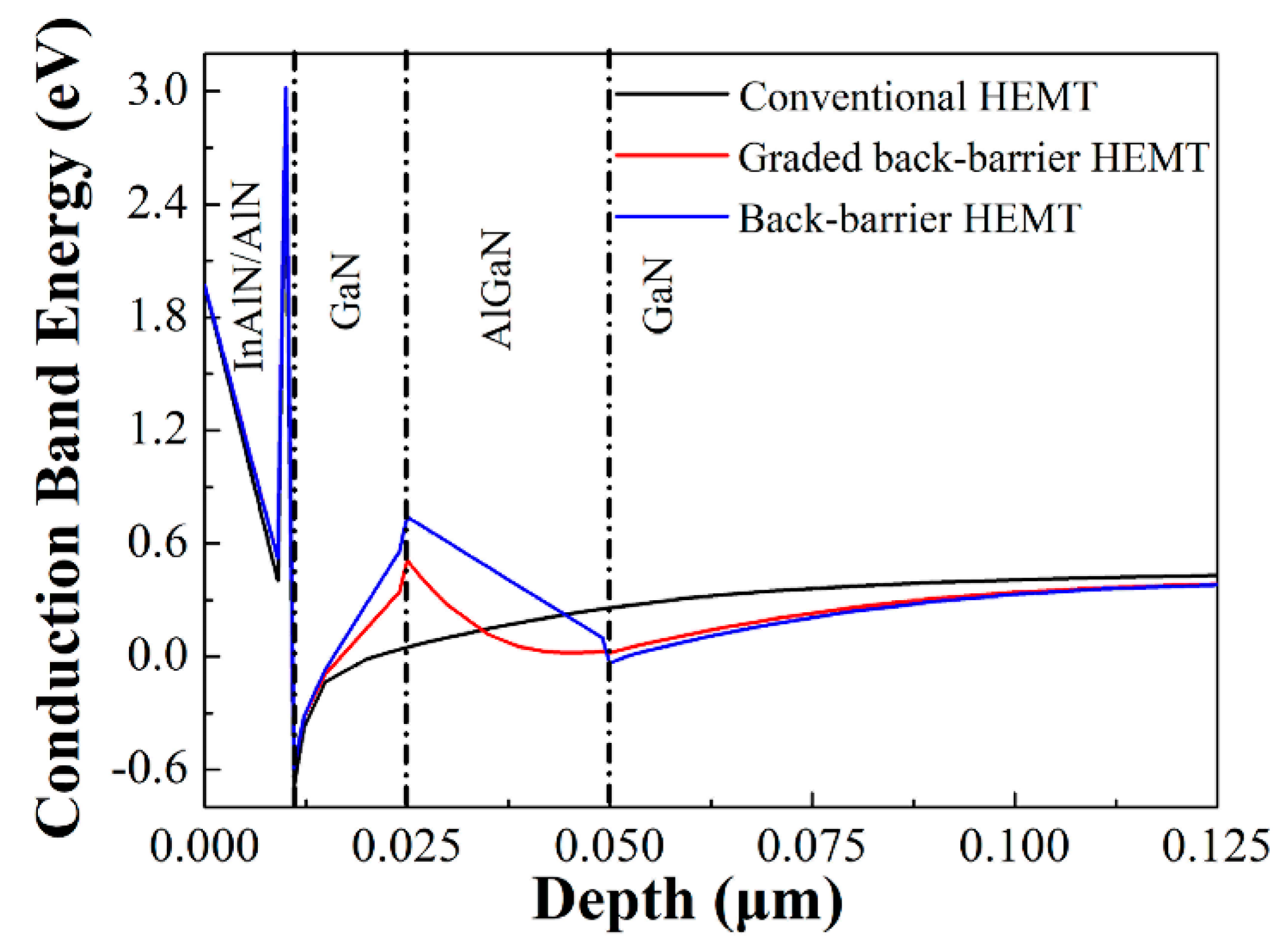
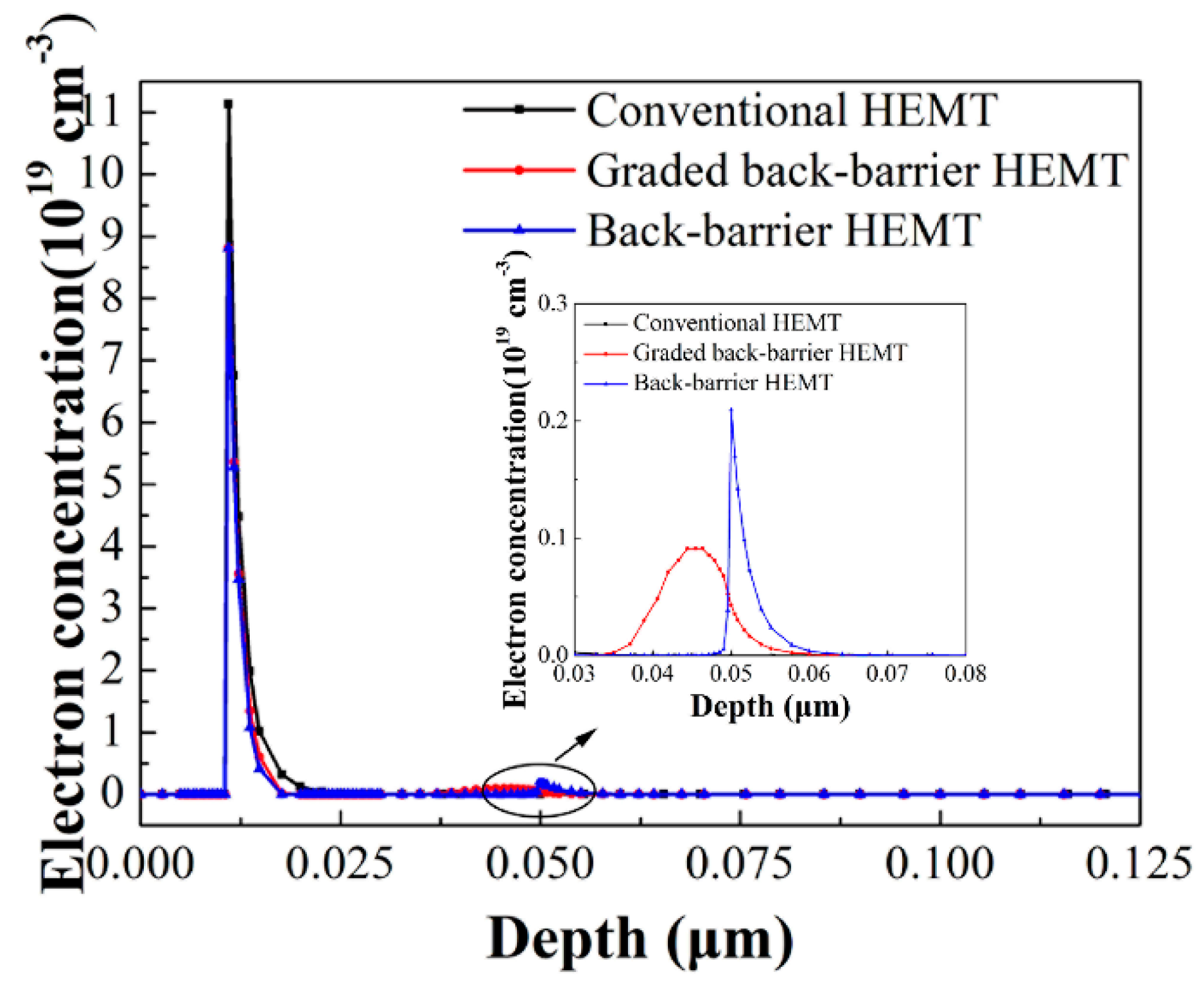

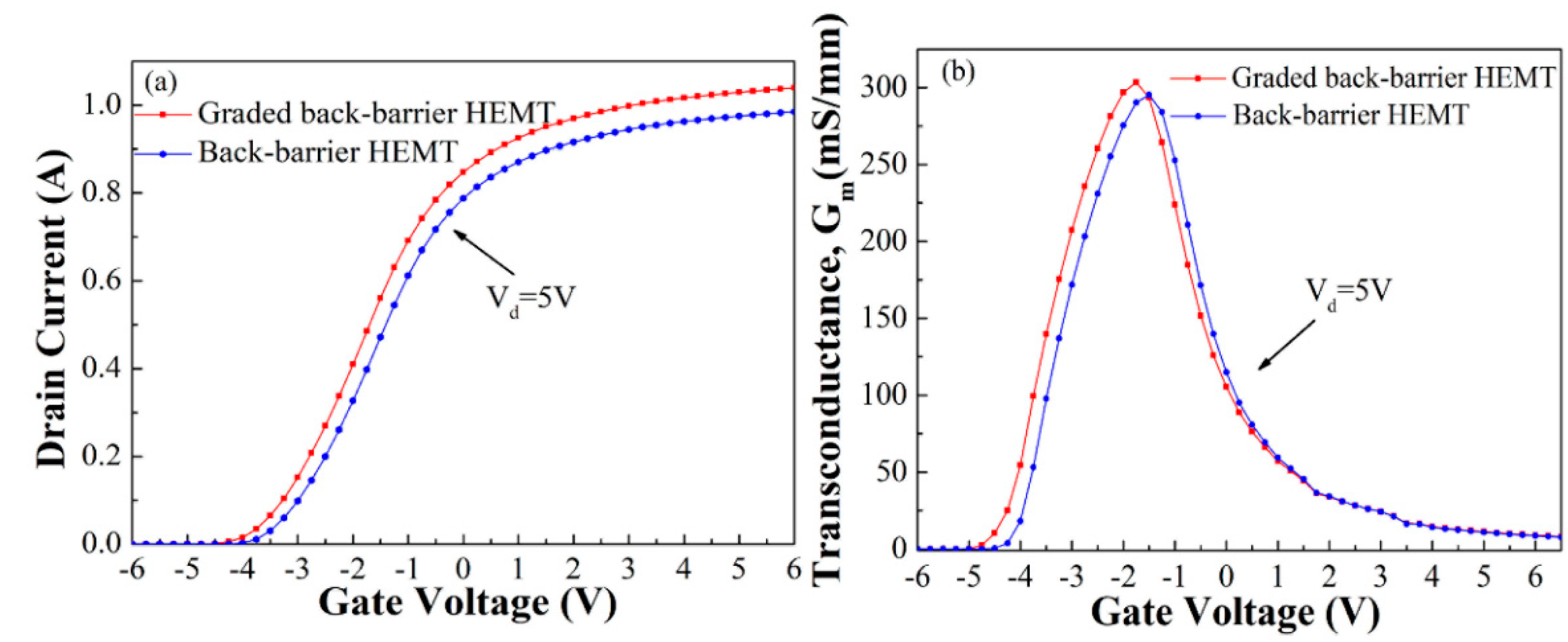
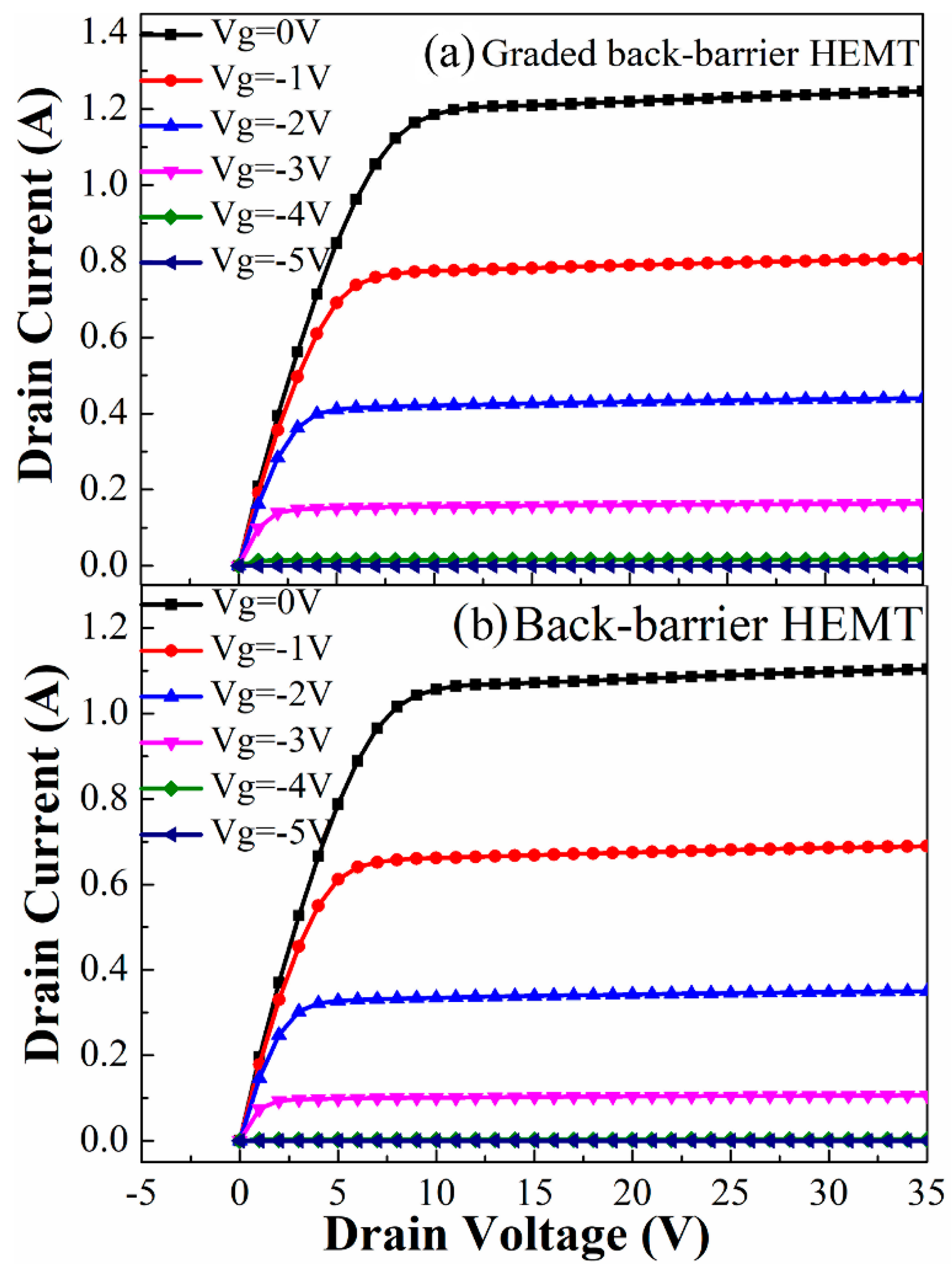

| Parameter | GaN | AlN | Al0.83In0.17N | Al0.1Ga0.9N |
|---|---|---|---|---|
| Band gap (eV) | 3.42 | 6.15 | 4.62 | 3.58 |
| Permittivity | 10.28 | 10.31 | 11.04 | 10.28 |
| Hole mobility (cm2/Vs) | 22 | 14 | 82 | - |
| Saturated velocities (υsat) for electrons (107 cm/s) | 2.0 | 2.17 | 1.1 | - |
| Spontaneous polarization, Psp (C/m2) | −0.034 | −0.090 | −0.072 | −0.038 |
© 2019 by the authors. Licensee MDPI, Basel, Switzerland. This article is an open access article distributed under the terms and conditions of the Creative Commons Attribution (CC BY) license (http://creativecommons.org/licenses/by/4.0/).
Share and Cite
Gu, Y.; Chang, D.; Sun, H.; Zhao, J.; Yang, G.; Dai, Z.; Ding, Y. Theoretical Study of InAlN/GaN High Electron Mobility Transistor (HEMT) with a Polarization-Graded AlGaN Back-Barrier Layer. Electronics 2019, 8, 885. https://doi.org/10.3390/electronics8080885
Gu Y, Chang D, Sun H, Zhao J, Yang G, Dai Z, Ding Y. Theoretical Study of InAlN/GaN High Electron Mobility Transistor (HEMT) with a Polarization-Graded AlGaN Back-Barrier Layer. Electronics. 2019; 8(8):885. https://doi.org/10.3390/electronics8080885
Chicago/Turabian StyleGu, Yan, Dongmei Chang, Haiyan Sun, Jicong Zhao, Guofeng Yang, Zhicheng Dai, and Yu Ding. 2019. "Theoretical Study of InAlN/GaN High Electron Mobility Transistor (HEMT) with a Polarization-Graded AlGaN Back-Barrier Layer" Electronics 8, no. 8: 885. https://doi.org/10.3390/electronics8080885
APA StyleGu, Y., Chang, D., Sun, H., Zhao, J., Yang, G., Dai, Z., & Ding, Y. (2019). Theoretical Study of InAlN/GaN High Electron Mobility Transistor (HEMT) with a Polarization-Graded AlGaN Back-Barrier Layer. Electronics, 8(8), 885. https://doi.org/10.3390/electronics8080885





